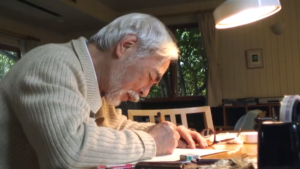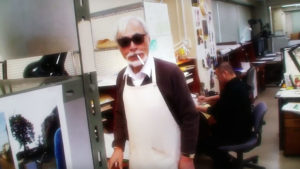By Kari Bowles
It must be said upfront that I am an ardent fan of Hayao Miyazaki; when asked who I consider the greatest living film director, I offer up Miyazaki. From his feature debut The Castle of Cagliostro in 1979, to the Academy Award winning Spirited Away in 2002, up to The Wind Rises in 2013, his films are a uniquely brilliant blend of popular escapism and rich philosophical meaning. The Japanese animator, now well into his seventies, has famously retired and come back multiple times. The first announcement was upon the completion of Princess Mononoke (1997); four films later, in 2013, he declared that he “means it this time”. It’s not that he didn’t mean it; he just can’t help himself.
Neverending Man: Hayao Miyazaki, a documentary directed by Kaku Arakura for Japan’s NHK television network, chronicles Miyazaki’s semi-retirement in 2015. Though insisting he will not direct another feature length project, the documentary follows Miyazaki as he directs a short film for the Studio Ghibli Musuem. The short, about a caterpillar named Boro making a perilous journey from one tree to another across the sidewalk in a park, is Miyazaki’s first experience working with CGI rather than cell animation. The director is both puzzled at the medium, and intrigued by what it can offer.
 Unlike the earlier documentary The Kingdom of Dreams and Madness (Mami Sunada, 2013), which focused more on the formation of Studio Ghibli and Miyazaki’s partnership with the late Isao Takahata, Neverending Man is more deliberately narrow in its purpose, as well as in its style. The fly-on-the-wall, unobtrusive approach to its subject is in line with 60s and 70s cinema vérité filmmaking associated with documentarians like the Maysles brothers or Fredrick Wiseman. Arakura is even less artistically minded than the aforementioned austere filmmakers, it must be said. The film has very little that will grasp the attention or interest of those viewing it who aren’t already Miyazaki fans. English voice-over narration was added for the film’s limited North American distribution, in an attempt to mitigate this issue, but it’s fundamentally superfluous.
Unlike the earlier documentary The Kingdom of Dreams and Madness (Mami Sunada, 2013), which focused more on the formation of Studio Ghibli and Miyazaki’s partnership with the late Isao Takahata, Neverending Man is more deliberately narrow in its purpose, as well as in its style. The fly-on-the-wall, unobtrusive approach to its subject is in line with 60s and 70s cinema vérité filmmaking associated with documentarians like the Maysles brothers or Fredrick Wiseman. Arakura is even less artistically minded than the aforementioned austere filmmakers, it must be said. The film has very little that will grasp the attention or interest of those viewing it who aren’t already Miyazaki fans. English voice-over narration was added for the film’s limited North American distribution, in an attempt to mitigate this issue, but it’s fundamentally superfluous.
The value the film has then is in providing a glimpse at the working process and values of a great artist. We see Miyazaki obsessing over the way the CGI caterpillar is meant to move its body, how many tiny hairs should pop out when it first emerges from the cocoon, how the giant water droplets will reflect morning light. Miyazaki continually intones, “I’m a burned out old man”, yet his energy and well-nigh crushing perfectionism is inspirational and daunting to his younger colleagues. Toshio Suzuki, Studio Ghibli’s longtime producer, observes at one point that “Hayao loves working with young people. He feels energized by them. The problem is, after they work with Hayao the young people aren’t young anymore.” The question of Studio Ghibli’s future post-Miyazaki has been a pressing one for both its animators and its fans. Neverending Man doesn’t presume to answer this question; we can only hope that the next generation has a few people with a fraction of Miyazaki’s artistic commitment and storytelling craft.





Leave a Reply